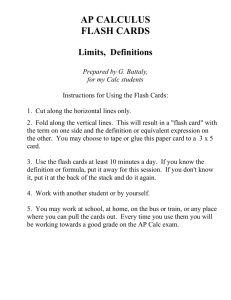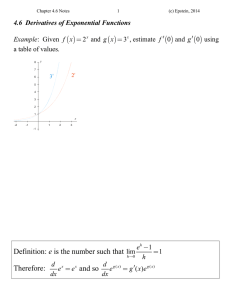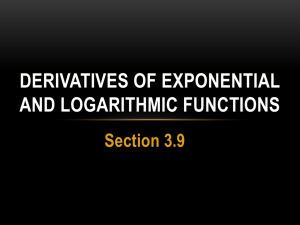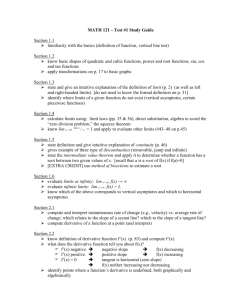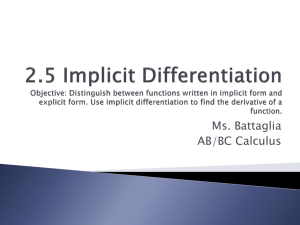( )
advertisement
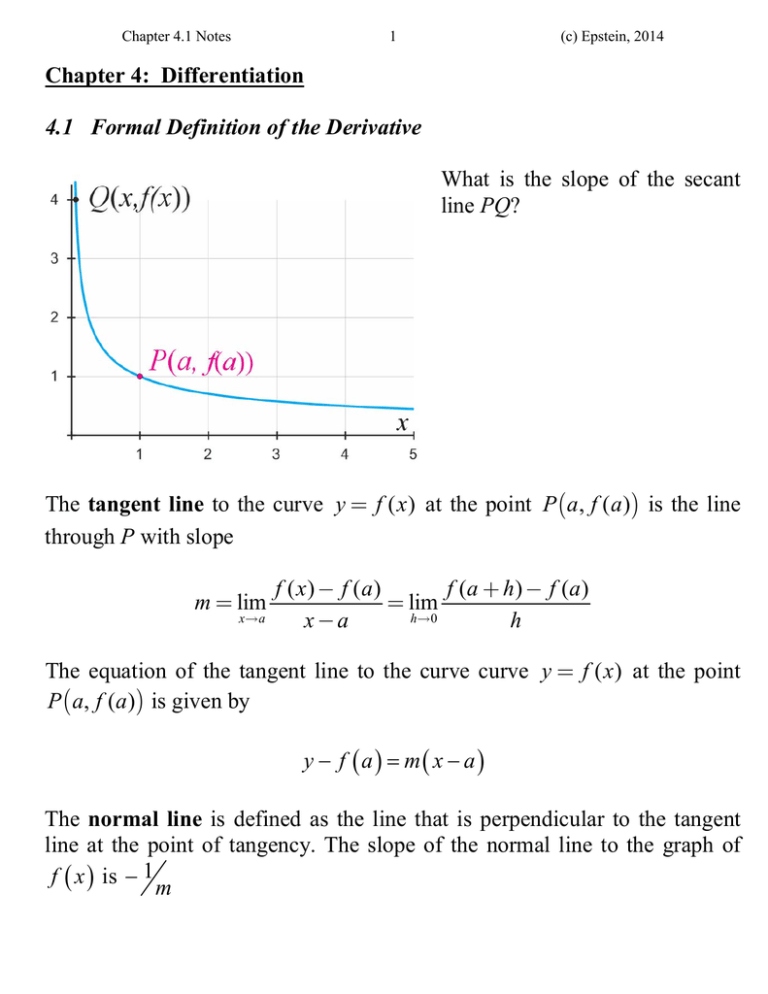
Chapter 4.1 Notes 1 (c) Epstein, 2014 Chapter 4: Differentiation 4.1 Formal Definition of the Derivative What is the slope of the secant line PQ? The tangent line to the curve y = f ( x) at the point P (a, f (a )) is the line through P with slope m = lim x a f ( x) - f (a) f ( a + h) - f ( a ) = lim h 0 x-a h The equation of the tangent line to the curve curve y = f ( x) at the point P (a, f (a )) is given by y f a m x a The normal line is defined as the line that is perpendicular to the tangent line at the point of tangency. The slope of the normal line to the graph of f x is 1 m Chapter 4.1 Notes 2 (c) Epstein, 2014 Example: a) Find the slope of the tangent line to the curve y = x 3 at (-1, -1) using both definitions given above. b) Find the equation of the tangent line. c) Graph the curve and the tangent line Chapter 4.1 Notes 3 (c) Epstein, 2014 Example: Find the equation of the tangent line and the normal line to the curves below at the given point. x 1 a) y = , (1,1) , (0,0) b) y = 1- x x Chapter 4.1 Notes 4 (c) Epstein, 2014 The average rate of change of y = f ( x) with respect to x is f ( x2 ) - f ( x1 ) Dy = Dx x2 - x1 The instantaneous rate of change of y = f ( x) with respect to x at the point x = x1 is f ( x2 ) - f ( x1 ) Dx lim = lim Dx0 Dy x2 x1 x2 - x1 Example: The population P (in thousands) of a city from 1990 to 1996 is given in the following table: year 1990 1991 1992 1993 1994 1995 1996 P 105 110 117 126 137 150 164 (a) Find the average rate of growth from (i) 1992 to 1996 (iv) 1992 to 1993 (b) Estimate the instantaneous rate of growth in 1992 by measuring the slope of a tangent. Chapter 4.1 Notes 5 (c) Epstein, 2014 If the position of an object at time t is given by the function s = f (t ) , then the velocity of the function at time t = a is f ( a + h) - f ( a ) v(a ) = lim h 0 h Example: The displacement (in meters) of a particle moving in a straight line is given by s = t 2 - 8t + 18 where t is measured in seconds. a) Find the average velocity over the following time intervals [3,4] [3.5,4] [4,5] [4,4.5] b) Find the instantaneous velocity when t = 4 c) Draw the graph of s as a function of t and draw the secant and tangent lines from parts (a) and (b). Chapter 4.1 Notes 6 (c) Epstein, 2014 Example: If a cylindrical tank holds 100,000 gallons of water, which can be drained from the bottom of the tank in 1 hour, then Torricelli’s Law gives the volume V of water remaining in the tank after t minutes as 2 æ ö÷ t V (t ) = 100,000çç1- ÷÷ 0 £ t £ 60 çè 60 ø Find the rate at which the water is flowing out of the tank after 20 minutes. Chapter 4.1 Notes 7 (c) Epstein, 2014 The derivative of a function f ( x) at a number a, denoted by f ¢(a ) f ( x) - f (a) f ( a + h) - f ( a ) = lim f ¢( a ) = lim x a h 0 x-a h Interpretations Slope of the tangent line at x = a Instantaneous rate of change at x = a Velocity at x = a Notation: f x d df dy y f x dx dx dx Example: Find f ¢(a ) for the given functions a) f ( x) = x 3 + 5 x + 2 at a = 1 b) f ( x) = x -1 at a = 5 Chapter 4.1 Notes 8 (c) Epstein, 2014 Example: Each limit represents the derivative of some function f at some number a. State f and a in each case. (2 + h) - 8 3 a) lim h 0 h cos x + 1 x3p x - 3p b) lim Given a function f(x), we associate with it a new function f’, called the derivative of f defined by the equation below f ¢( x ) = lim h 0 f ( x + h) - f ( x) h A function f is differentiable at a if f’(a) exists. It is differentiable on an open interval (a, b) if it is differentiable at every number in the interval. If f is differentiable at a, then f is continuous at a. Example: At what values of x is f not differentiable? f ( x) 5 -5 5 x Chapter 4.1 Notes 9 (c) Epstein, 2014 Example: Match the graph of each function in (a) – (d) with the graph of its derivation in I – IV. Explain (a) (b) (c) (d) (I) (II) (III) (IV) Example: Find the derivative of the given functions using the definition of derivative. State the domain of the function and the domain of its derivative. x +1 (a) f ( x) = 6 - x (b) f ( x) = x -1 1 1 (c) g ( x) = 2 (d) G (t ) = x t -1
